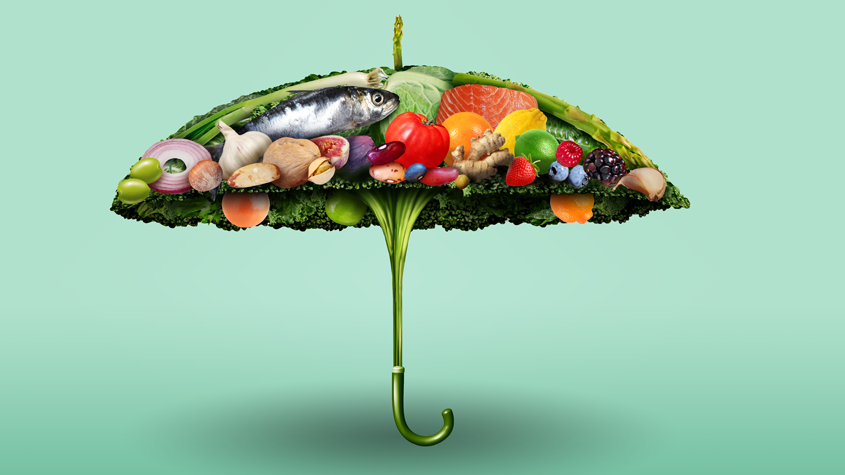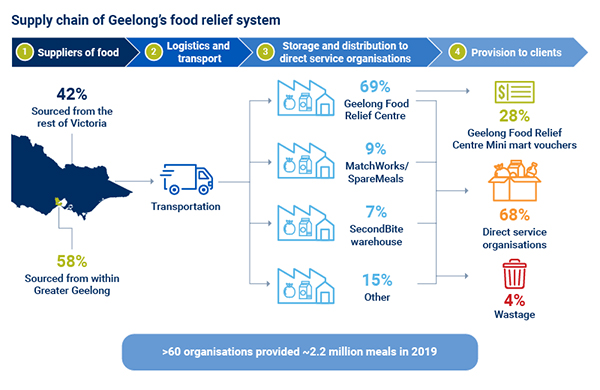
A systems approach to food insecurity
Supply chain mapping, leveraging data and enhancing the collaboration in food relief systems are all ways that key players can support everyone in the community to access the food they need.

- Food insecurity continues to be a challenge for many Australians, with 1 in 25 people running out of food and being unable to buy more. Covid-19 has exacerbated this as insufficient income leads to many people unable to access sufficient, nutritious food.
- Regional food relief systems include many different organisations working in complex supply chains to provide access to quality food for vulnerable residents.
- Local government and key system stakeholders are well placed to support regional food relief systems. This includes developing a better understanding of the local system through supply chain mapping and building an evidence base of food supply and demand needs; and playing a backbone role for the system’s collaborative networks, processes and policies.
- SVA’s work with the City of Greater Geelong evidenced how these activities can lead to improvements in a region’s food relief system providing more meals for vulnerable people.
Access to food is a fundamental human right.1 Affordable, nutritious food enables greater wellbeing and the ability to live healthy lives. However, it is estimated that 1 in 25 Australian adults will experience running out of food and not being able to buy more.2 This rate increases to almost 1 in 5 for Aboriginal and Torres Strait Islander adults.3
Due to the economic and social impacts of Covid-19, we know that many Australians have experienced food insecurity for the first time.4 For example, the impact of Covid-19 restrictions on employment and income in Victoria led to 23% of Victorians having to rely on a restricted range of low-cost, unhealthy food due to running out of money.5
Food insecurity occurs ‘whenever the availability of nutritionally adequate and safe foods, or the ability to acquire such food in socially acceptable ways, is limited or uncertain’.6 This insecurity occurs along a spectrum and encompasses more than ‘running out of food and being unable to afford more’ (defined as food insecurity with hunger).7 Food insecurity without hunger covers a wider range of issues, including being worried about having enough food and relying on low-cost, low quality food to avoid running out.
For example, in Victoria it has been estimated that ~4% of the population experienced food insecurity with hunger, however ~37% experienced food insecurity without hunger (Figure 1).8 Food insecurity without hunger can also be a predeterminant for individuals experiencing food insecurity with hunger.

There are several drivers of food insecurity and it is important to recognise the systemic causes. These primarily relate to inadequate income, through unemployment, underemployment and inadequate welfare support. A 2020 survey of Australians found that the new rate of JobSeeker and the Coronavirus Supplement dramatically reduced levels of financial and personal distress leading to declines in the number of people skipping meals, as well as people reporting they could not afford fresh fruit and vegetables.10
In addition to inadequate income, there are also other contributing factors to food insecurity including poor access to nutritious food or limited education on nutrition.
Food relief systems
Food relief systems aim to provide food to people experiencing food insecurity. They are often place-based, providing local support to a region’s food needs. The supply chains for food relief are complex, involving a variety of different organisations. These include food producers, suppliers, retailers, large and small non-profit organisations, and community groups. The organisations within the supply chain often operate with limited funding, relying heavily on donations and a largely volunteer workforce. It is therefore valuable to consider a systems approach to improving food insecurity in a region.
Opportunities to support the system
Local councils are well placed to understand, measure and support their region’s food relief system.11 There are two opportunities for local government, or other key system players, to support by:
- Developing a better understanding of the local system through mapping the supply chain and building an evidence base of a region’s food supply and demand needs;
- Playing a backbone role for the system’s collaboration networks, processes and policies to enable better provision of food relief.
These opportunities were also identified in VicHealth’s Food for All program and resources which aimed to assist local government in advancing regional food security.12
1. Mapping and building an evidence base of the local system
SVA’s work with the City of Greater Geelong (CoGG) portrays how mapping the food relief system and building an evidence base on supply and demand can lead to insights about potential system improvements. By gathering and understanding data on this complex supply chain, system stakeholders are better placed to identify where to focus resources to improve quality and quantity of food relief.
Case study
The CoGG was keen to understand how they could better support the region’s food relief system. Like many regional areas, Geelong has low-socio-economic areas that experience higher rates of food insecurity than the general Australian population.13 CoGG engaged Social Ventures Australia Consulting to assist in:
- Documenting and mapping the current food relief system in the region;
- Identifying improvement opportunities, including the investment and resourcing required;
- Understanding governance options for the future food relief system, including the supporting role which CoGG could play.
Consulting with key stakeholders within the Geelong food relief system, we mapped Geelong’s food relief supply chain.

There were over 60 different organisations working to provide food to those in need in the region, along with several community organisations providing funding and research to support the food relief system. We broadly mapped the important roles these organisations (and individuals) played within the supply chain (see Figure 2):
- Suppliers of food: Organisations and businesses producing and manufacturing food, and individual households who donate food. Approximately 60% of food was donated from within the Greater Geelong region by local businesses and members of the community. The remainder was sourced from Victoria outside Greater Geelong.
- Logistics and transportation: Organisations and individuals collecting and transporting food products to the region. In Geelong, these included supply chain companies, large national non-profit organisations, and community drives where Geelong residents donated their own food to be distributed through the system.
- Storage and distribution to direct service organisations: Organisations who receive, sort and store food relief, ready for distribution to clients.14 This includes breaking down bulk food donations and sorting appropriate quantities into food boxes for direct service organisations to pick up and provide to clients. The majority of food relief (~70%) was being stored and distributed by the region’s food hub, Geelong Food Relief Centre (GFRC).15
- Provision to clients: In Geelong, almost 70% of food relief was provided to clients by ‘direct service organisations’, which included over 50 charities, churches, schools and community organisations. Relief took many forms including cooked meals, pre-packaged meals, food boxes, food vouchers, and donated food supplies. Of note, around 28% of food relief was acquired from the GFRC’s ‘mini-mart’ supermarkets with food vouchers purchased for clients by charities.
An added complexity of the food relief system was that some organisations played multiple roles across the supply chain. For example, SecondBite collected and transported food relief (logistics and transportation) from Victoria and stored it within its Beckley Park warehouse for other organisations to pick up and distribute to clients (storage and distribution).
Based on this mapping and data, we estimated that the Geelong food relief system provided an estimated 2.2 million meals to clients in need in 2019. This was an extraordinary effort. It was contributed to by the many community organisations and charities who were largely under-funded, heavily reliant on donations and volunteers, yet working innovatively to keep food wastage levels low (less than 5%).
However, our analysis estimated that the 2019 demand for food relief in Geelong was ~2.5 million meals – outweighing the 2.2 million meals provided.16 Considering Geelong’s expected population growth, over 3.2 million meals may be needed from the region’s system by 2031.17 If the region has an increase in any of the drivers of food security (see above), this need could be greater than 3.2 million meals.
Given that demand for food relief was growing, we looked at the system to understand opportunities to increase supply. As noted above, the GFRC plays an important role as the region’s food hub, securing, receiving, storing and distributing food relief to a number of direct service organisations and clients. Food hubs are complex enterprises, working to create large, consistent and reliable supplies of food by actively coordinating supply chain logistics in a region.18
In Geelong, the quantity of bulk food being distributed by the GRFC had grown by ~540% between FY16 and FY19. This was achieved with a largely volunteer workforce and only a 28% growth in income. With the increase in quantity, GFRC had outgrown its warehouse. Almost 20,000kg of food, via over 50 deliveries, was being received each week through a single access road and single loading dock. The same loading dock was also used by direct service organisations picking up food for distribution to clients. The current site was constrained in its capacity to accept more food and provide a consistent supply to direct service organisations.
This analysis of data resulted in a Council commitment of $1 million in capital funding towards a new GFRC site to increase its capacity and $700,000 of operational support over five years.
2. The role of local government
It is important for a region’s food relief system to be place-based, community-driven and collaborative. VicHealth identified a number of ways in which local government could take the lead in addressing food insecurity, including building a local evidence base on the food relief system, leveraging its funding capacity to drive change, working in partnership with community and food relief players, and developing policies and planning to improve community access to healthy food.19
Some of the ways in which local government, or another major player, can perform a key backbone role in food relief systems are:
- Mapping the system’s supply chain and building a local evidence base on supply and demand.
- Coordinating and convening the region’s food assistance organisations to be aligned on a clear common agenda for addressing food insecurity and a shared measurement framework.
- Supporting ongoing data collection, which measures and values the impact of the system achieved through significant volunteer labour, donated goods and donated services.
- Leveraging data collected to prioritise allocation of funding and resources to improve system efficacy and the sustainability of local food relief services.
- Incorporating food relief into government policy and planning whilst continuing to increase community awareness of healthy eating.
Conclusion
The experience of Geelong highlights two key lessons for other regional food relief systems and the community organisations and local councils involved. Mapping a region’s food relief system and leveraging data on supply and demand can lead to insights on improvements to system efficacy. Local government, or other key players, can offer additional support by enhancing system collaboration, coordinating ongoing data collection and monitoring, and developing policies to improve healthy eating amongst residents.
Supporting and optimising these systems are critical to ensuring all Australians have access to affordable, quality, nutritious food.
We know that addressing the systemic causes, including inadequate income, are key to reducing rates of food insecurity.20 Whilst work needs to be done on addressing this, local food relief systems are increasingly important to support the community’s health and wellbeing. Supporting and optimising these systems are critical to ensuring all Australians have access to affordable, quality, nutritious food.
- United Nations, 1948, ‘Universal Declaration of Human Rights’, Article 25, “Everyone has the right to a standard of living adequate for the health and well-being of himself and of his family, including food”.
- Australian Institute of Family Studies, 2020, Understanding Food Insecurity in Australia, p7.
- Australian Institute of Family Studies, 2020, Understanding Food Insecurity in Australia, p2.
- Foodbank Hunger report, 2020, p8.
- VicHealth, 2020, Coronavirus Victorian Wellbeing Impact Study, p69.
- Food and Agriculture Organization of the United Nations, ‘Food Security and Nutrition for All’, (2019); See also Radimer, K. L., & Radimer, K. L. (2002). Measurement of household food security in the USA and other industrialised countries. Public Health Nutrition, 5(6a), p861.
- Victorian Agency for Health Information 2017, Challenges to healthy eating – food insecurity in Victoria, p3.
- Victorian Agency for Health Information 2017, Challenges to healthy eating – food insecurity in Victoria, p4.
- Ibid
- Australian Council of Social Services, 2020, I Can Finally Eat Fresh Fruit And Vegetables – Survey of 955 people receiving the new rate of JobSeeker and Other allowances, p1.
- Vichealth, Food for all – Ten ways local government can act on food security, (2010).
- Vichealth, Food for all – Ten ways local government can act on food security, (2010).
- Greater Geelong postal areas, Index of Relative Socio-economic Disadvantage (IRSD) SEIFA scores, ABS (2019)
- We defined direct service organisations as those who delivered food relief directly to recipients through a variety of different methods.
- A ‘regional food hub’ has been defined as “a business or organization that actively manages the aggregation, distribution, and marketing of source-identified food products primarily from local and regional producers to strengthen their ability to satisfy demand”. See Barham, J., Tropp, D., Enterline, K., Farbman, J., Fisk, J., & Kiraly, S, 2012, Regional food hub resource guide, US Department of Agriculture.
- We estimated Geelong’s demand for food relief meals based on (1) current and expected population growth, (2) current percentage of population who experience food insecurity in a 12 month period; (3) estimated percentage of people experiencing food insecurity who do not eat for an entire day per week (i.e. require 3 food relief meals per week). See: Foodbank Victoria ‘Foodbank Hunger Report’ (2019) and id. Forecasts ‘Population and household forecasts, 2016 to 2041’ (2019).
- See above.
- See Barham, J., Tropp, D., Enterline, K., Farbman, J., Fisk, J., & Kiraly, S, 2012, Regional food hub resource guide, US Department of Agriculture, p4.
- Vichealth, Food for all – Ten ways local government can act on food security, (2010).
- Australian Institute of Family Studies, 2020, Understanding Food Insecurity in Australia, p10.







